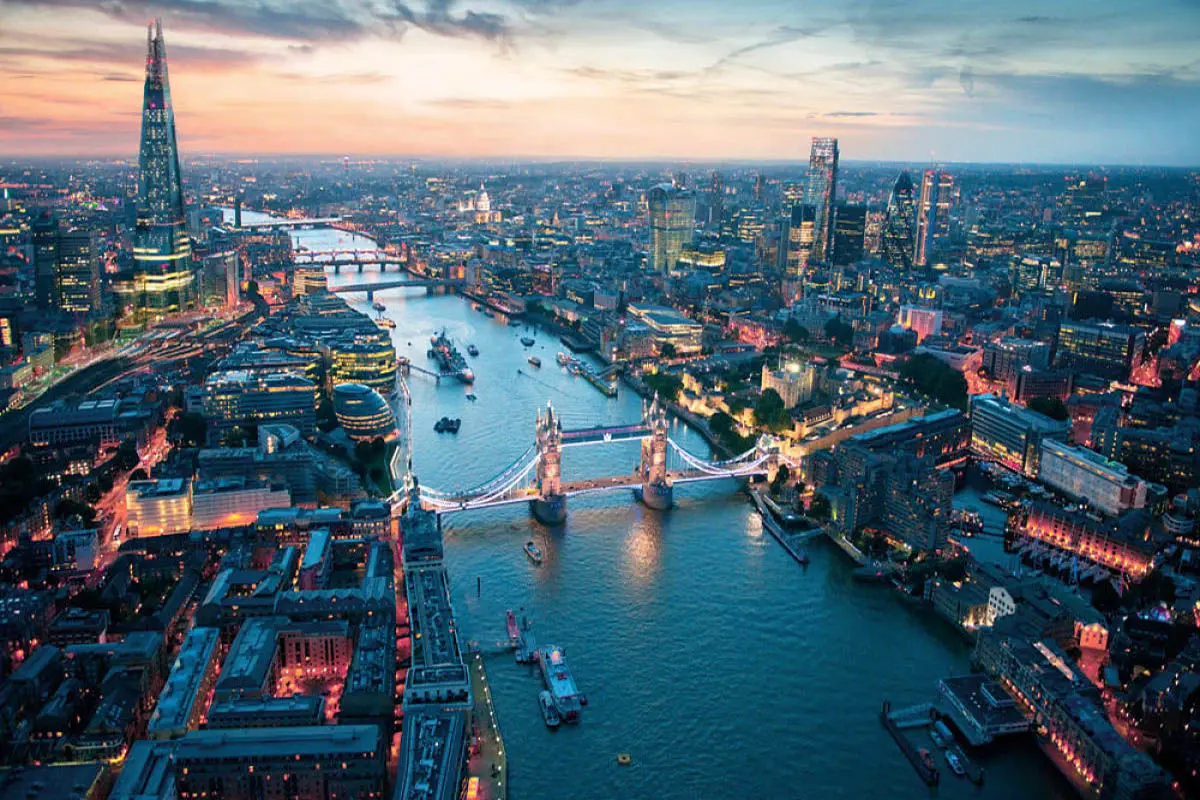
INTRODUCTION
Welcome to London. Located on the banks of the River Thames, London is the capital and largest city of England and the United Kingdom. You will be able to discover the city with this audioguide (audioguides).
London was founded under the rule of the Roman Empire between the 1st and 5th century AD. By the 3rd century, Londinium, as it was then known, was an important port city with some 50,000 inhabitants.
In the 13th century, nearby Westminster was declared the center of government. A subsequent trade boom with Europe consolidated the city’s claim as the capital of the kingdom.
During the 15th century, London developed a sizable textile industry, and its port became its primary distribution center. The expansion of maritime trade, which was established by the Tudors and continued by the Stuarts, meant that by the mid-17th century, London’s population had surpassed 500,000.
A devastating plague epidemic killed 70,000 people in 1665. A year later, a gigantic fire destroyed four-fifths of the city. This led to the construction of the new London, much of which can be seen today.
A large part of modern London is from the Victorian era. Until the beginning of the 19th century, the capital resided within the limits of the medieval city which had a perimeter of one square mile.
WESTMINSTER PALACE
Saint Edward the Confessor ordered the construction of a palace on the borders of the River Thames to use as his residence at the end of the 11th century
A fire destroyed part of the building in 1529 which prompted the residing king, Henry VIII, to move to another palace. Since then, it has been used by the two Houses of Parliament and the Court of Justice.
Another terrible fire, this time caused by a stove in the House of Lords, almost completely destroyed the palace in 1834.
After the catastrophe, the palace was rebuilt from the ground up, and the few structures that remained were conserved.
During World War II, the Germans succeeded in bombing the House of Commons.
At present, the palace consists of about 1,200 rooms. Within them, with the audioguide (audioguides) we can see a collection of artworks and artifacts that tell of the Parliament’s history, including portraits, statues, furniture, and adornments from the era.
The palace is flanked by Big Ben and the Victoria Tower, an imposing spire that houses the originals of all Parliamentary legislature since 1497.
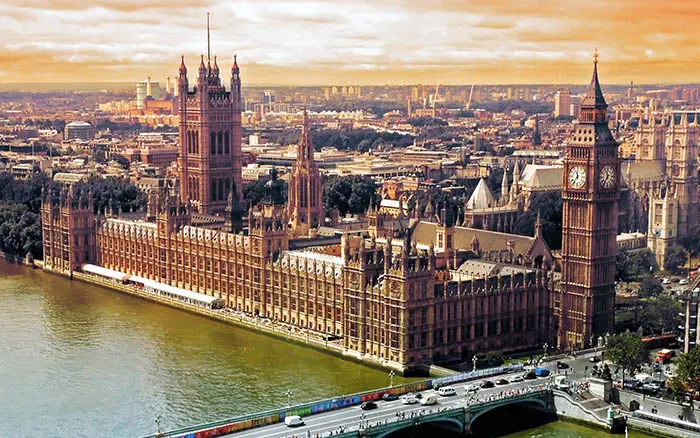
WESTMINSTER ABBEY
The origins of Westminster Abby date back to 1065 when the construction was a humble Benedictine monastery. Later, it was rebuilt in a Gothic style in the 12th and again in the 16th century. At the end of this period, the Benedictine monks dissolved the Order, and the monastery passed into the hands of the English Crown.
The Abbey has been the scene of numerous coronations and burials for members of the English monarchy. The funeral of Princess Diana is perhaps the most well-known.
Inside the main hall of the Abbey is King Edward's Chair, where all new monarchs must sit during their coronation. The Stone of Scone once lay just below the chair, which was a precious stone the Scottish used in their own coronations.
This stone was stolen from the Scottish by the English in the 13th century. In 1950, it was taken back again by Scottish nationalists.
Conflict over the stone ended when it was split in two so that both sides could retain a piece. However, in 1996 the English Prime Minister decided to return the fragment that resided in Westminster Abbey to its place of origin, the Edinburgh Castle.
A highlight of the interior are the tombs and mausoleums of British kings and queens, as well as those of notable Britons such as Lady Chapel, Isaac Newton, and Charles Darwin.
One of the most well-known sections is "Poet’s Corner": with the audioguide (audioguides) you can find the tombs of the literary greats such as Charles Dickens, William Shakespeare, Geoffrey Chaucer, Samuel Johnson, and Rudyard Kipling.
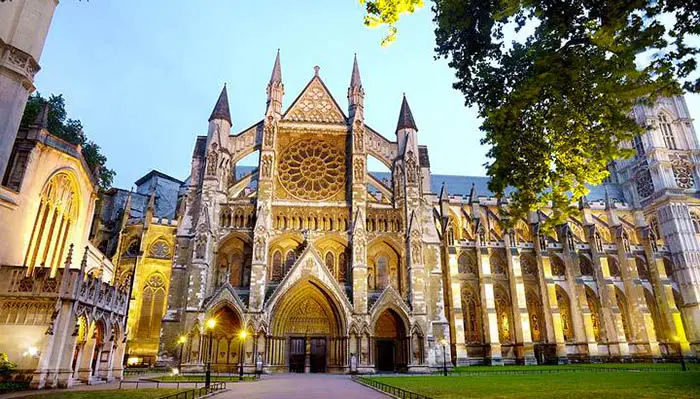
THE TOWER OF LONDON
Next stop of this audioguide (audioguides), the Tower of London was built by William the Conqueror as a fortification towards the end of the 11th century and it has evolved ever since.
The complex is composed of several buildings protected by a double wall and a defensive moat, with the White Tower serving as the central building.
The fortification has had numerous different uses over time.
It was a prison for more than 900 years. Anyone who went against the crown was locked up here in horrible conditions and possibly tortured.
Executions were occasionally carried out here. The condemned included aristocrats, ousted kings and clerics accused of treason. Some of those remembered here for having lost their head include Anne Boleyn, Lady Jane Grey, and Baron William Hastings.
Stories of ghostly apparitions have emerged from these events. The most famous is that of Anne Boleyn, whose mortal remains rest in the Chapel Royal of St. Peter ad Vincula which lies within the Tower. It is said that in 1536, her spirit was seen walking around the chapel holding her detached head.
The tower guards the Crown Jewels, a collection of crowns, weapons, armor, sceptres, and jewels which the Queen continues to use for important ceremonies today.
Some say that during the Second World War, the Crown Jewels were secretly taken to Montreal in Canada, along with gold bullion from the Bank of England, for fear of being ransacked during a German invasion.
The tower has also served as a weapons warehouse, a menagerie, a public archive, a Royal Mint, and an observatory.
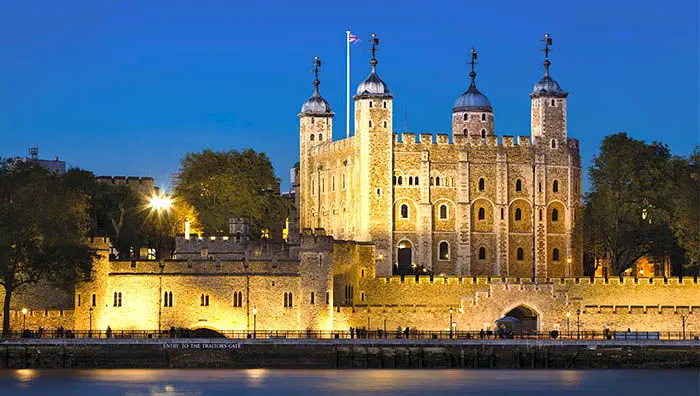
TOWER BRIDGE
Numerous bridges needed to be built to expand the city to the other side of the River Thames. The government decided to create a great new drawbridge in 1875 to avoid disrupting waterborne traffic. Powered by steam engines and pressurized water cylinders, the system was revolutionary at the time.
A corresponding museum, located in the two towers around the bridge, explains how this novel system works. Also, a 42-meter high glass walkway has been installed which allows visitors to cross with the audioguide (audioguides) and to peer down at the traffic, pedestrians, and boats of the Thames below.
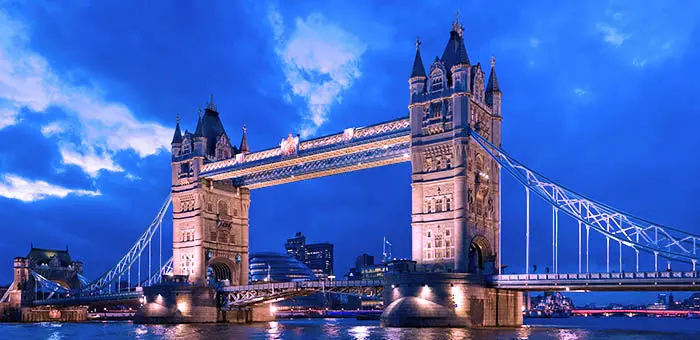
PICCADILLY CIRCUS
Famous for its bright neon signs, Piccadilly Circus boasts a wide range of entertainment options such as restaurants, shops, theaters, and nightclubs.
The name comes from a local tailor called Robert Baker. In the 17th century, Baker specialized in a type of collared shirt known the Piccadilly. He became very popular in London and constructed his residence, Piccadilly Hall, in the plaza. Over time, the area began to be known as Piccadilly. Later, the word "Circus" was added, which is common for circular plazas in Britain.
In the center is a landmark commonly referred to as the Eros Fountain. However, the statue presiding over it does not represent Eros, but rather Anteros, his twin brother and a symbol of selfless love. The statue was erected in memory of the Seventh Earl of Shaftesbury for his humanitarian work and his commitment to the rights of factory workers and miners.
During the Second World War, the statue was temporarily removed to prevent its potential destruction.
The audioguide (audioguides) of London continues in the next stop.
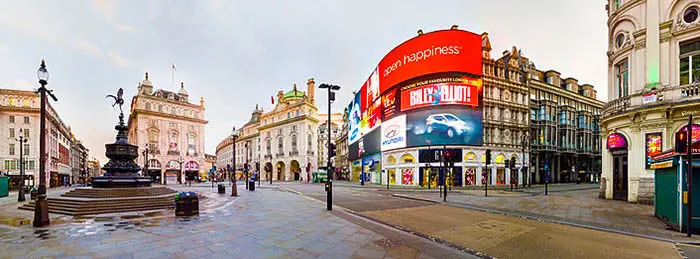
SAINT PAUL’S CATHEDRAL
Saint Paul’s has been a worship site since ancient times. In 604, a wooden church was built in honor of the Apostle Saint Paul on the site of an ancient Greek temple, making it the oldest church in England. In 1666, a great fire which lasted four days devastated the center of the medieval city and destroyed the church. Years later, it was rebuilt to become the grand cathedral you can see today.
Getting inside with the audioguide, a large dome takes center stage. At 85 meters high, it was inspired by the dome which Michelangelo designed for Saint Peter’s Basilica in Rome. The interior is composed of three circular galleries: the Whispering Gallery, which is known for its incredible acoustics, the Stone Gallery, and the Golden Gallery, which boasts excellent views of the city with the audioguide (audioguides).
The crypt is also part of the Cathedral structure. Within it lie the remains of historical British figures such as Admiral Nelson, Alexander Fleming, Winston Churchill and the Duke of Wellington.
During the Second World War, it was bombed several times which destroyed the great altar and part of the crypt, while the dome shifted laterally by a few centimeters. One bomb even landed within the structure without exploding. Thankfully, Royal engineers managed to deactivate it before the cathedral was totally destroyed.
Some of Britain’s most notable contemporary events have taken place within the cathedral such as Prince Charles and Princess Diana’s wedding, and the funerals of Winston Churchill and Margaret Thatcher.
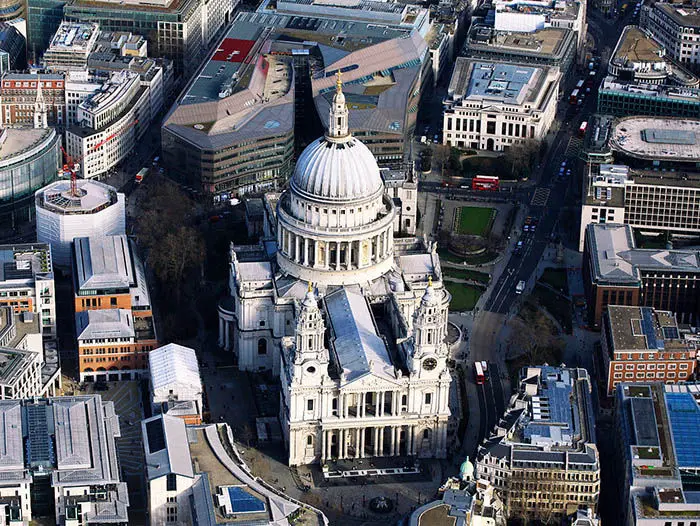
THE BRITISH MUSEUM
The British Museum began thanks to the physicist and collector Hans Sloane. After his death, he donated his entire collection of 80,000 artifacts to the British State so that they would endure throughout history.
His collection included about 40,000 books, various paintings, and antiquities from Egypt, Greece, Rome, the Middle East, and America.
The museum was initially located in the Montagu House. However, the rapid growth of the collection through new purchases and donations required it to be moved to the current building.
Today, the museum contains more than seven million items from all corners of the Earth, that you can discover with the audioguide (audioguides). Highlights include the Greek Gallery with fragments of the Parthenon, the Egyptian Gallery with statues of pharaohs, sarcophagi, and mummies, as well as the famous Rosetta Stone.
Due to a lack of space, its natural history collection was moved to the Natural History Museum. Later, the British Library became independent from the museum.
Facing the threat of another war, a bomb proof storage bunker was built on the outskirts of the city in 1933 to protect the largest and most important works.
The museum was bombed six times which damaged its exterior and interior. One of the most significant losses was a collection of some 250,000 books which were destroyed by fire.
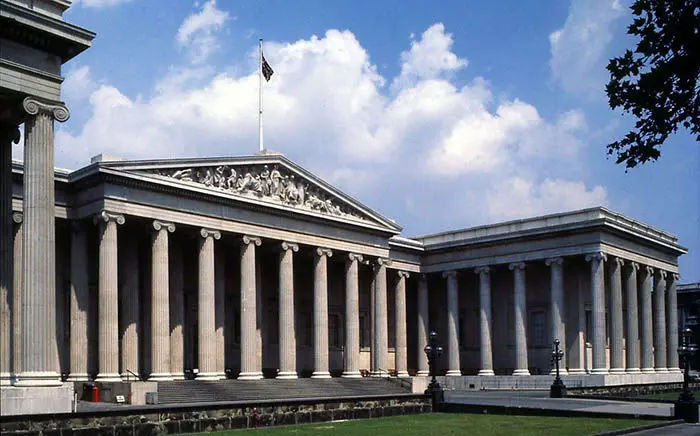
THE LONDON EYE
The London Eye was built in the year 2000 to celebrate the turn of the millennium. For this reason, it is also known as the Millennium Wheel.
The Ferris wheel stretches 135 meters high and has 32 cabins, the same number as there are districts in London. Each cabin weighs 10 tons and can accommodate up to 25 people. There is no cabin 13 as this number is considered unlucky,
The wheel moves 26 centimeters per second, making for a 30 minute round trip with the audioguide (audioguides).
The initial plan was to dismantle the wheel five years after its inauguration. However, the city decided to maintain the structure as it had become symbolic to London.
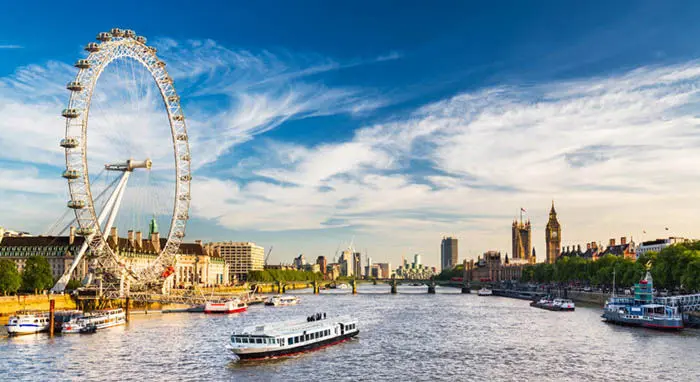
BIG BEN
Construction on Big Ben began the same year as Westminster Palace, directly after the great fire of London in 1834.
Although it is commonly known as Big Ben, its real name is actually Elizabeth Tower, which was given in 2012 to honor the queen serving 60 years on the throne. The real Big Ben is, in fact, the 14-ton bell inside.
The 106-meter tower has four clocks with a seven-meter diameter, one on each side. At its base, with the audioguide (audioguides) you can read a Latin inscription that says: “Oh Lord, keep safe our Queen Victoria I.”
Big Ben is considered among the world’s most reliable clocks because it rarely stops working. Even throughout the Second World War, it would dutifully tell the time. However, many Britons remember the New Year's Eve of 1962 when an accumulation of snow on the clock hands caused revellers to do the countdown around 10 minutes after midnight.
At present, Big Ben suffers from a half-meter lean which is caused by terrain conditions and the extension of the London Underground.
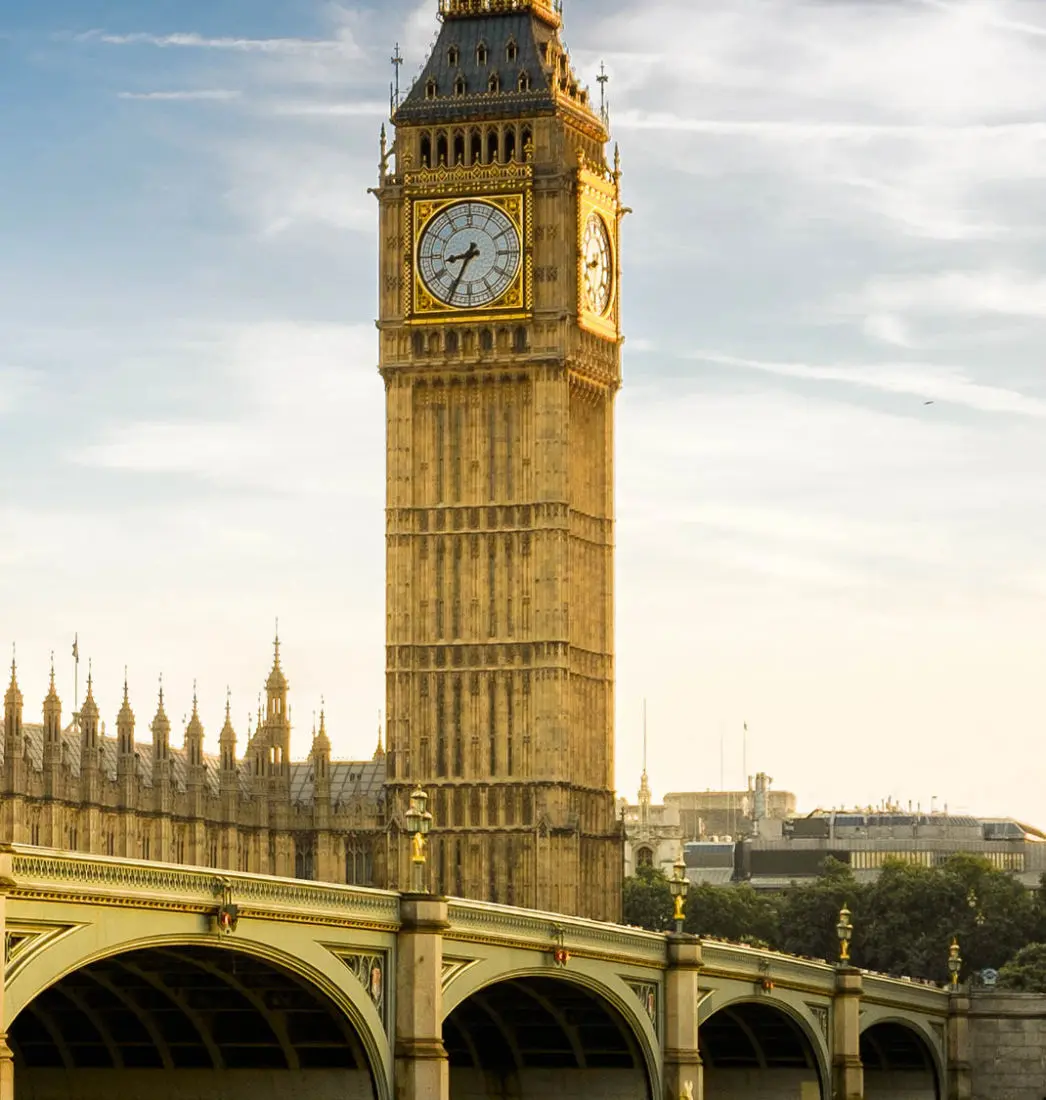
BUCKINGHAM PALACE
Buckingham Palace has been the residence of the British Royal Family since 1837. Currently, it is occupied by Queen Elizabeth II and is the site of official ceremonies and state visits.
It was built in 1703 for the first Duke of Buckingham. Some 60 years later, King George III acquired it as his private residence.
During the reign of Queen Victoria, the palace became the official residence of the monarchy. For this reason, a statue was installed in her honor, which can be seen presiding over the plaza opposite the palace.
The palace was bombed more than seven times during the Second World War because the Nazis believed destroying it would demoralize the nation.
The palace features 777 lavish rooms and the most extensive private gardens in London.
Its 19th-century Georgian style interior houses a large portion of the Royal Collection, which is an extraordinary set of artistic works.
The interior of the palace can only be visited with the audioguide (audioguides) in summer when the queen moves to another residence. On such a visit, you can see the State Rooms, the Royal Mews, and the Queen's Gallery.
The Changing of the Guards attracts thousands of visitors every year. Dressed in colossal fur hats, the guards perform a pompous ceremony in the central courtyard accompanied by a military band.
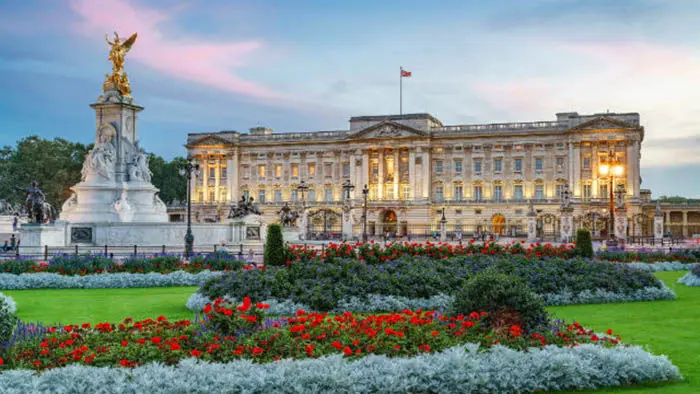
HYDE PARK
Spanning over 140 hectares, Hyde is the largest park in central London. The grounds once belonged to the Abbey of Westminster until King Henry VIII seized them to use as his private hunting grounds.
It opened as a public park in the 17th century.
Hyde Park held a famous international event known as the Great Exhibition in 1851. An enormous construction dubbed the Crystal Palace was built and later demolished to house the event.
An interesting section of the park is Speaker's Corner. Here, every Sunday morning Londoner’s meet to debate various issues. All kinds of topics can be discussed, so long as no one strays from the law. During the Second World War, it became famous as the only place in the city where people could speak freely about Hitler or Churchill without fear of reprisal.
The park houses some interesting monuments and memorials such as the Holocaust Memorial, the Princess Diana Memorial Fountain, and the Peter Pan Statue that you can find with the audioguide (audioguides).
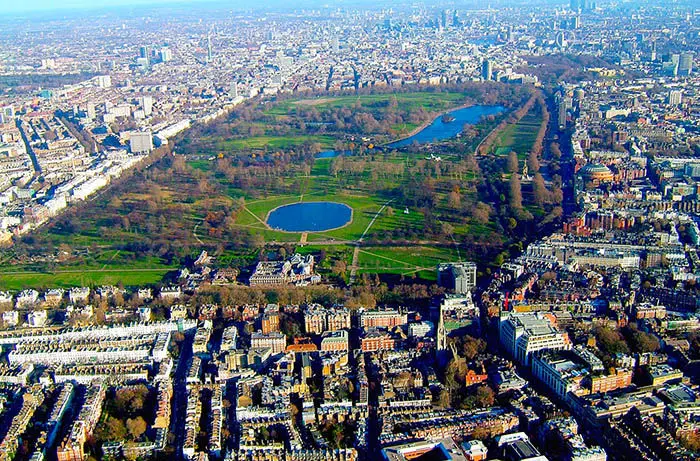
CAMDEN MARKETS
Next stop of our audioguide (audioguides), the Camden Markets are a set of six markets within the district of Camden Town. After beginning as a small flea market, they later became a craft market known as Camden Lock.
Currently - in addition to a large number of clothing, footwear, music, and accessory stores - mobile and permanent food stalls sell cuisine from all over the world. The facades of these stalls are famous for their wonderful decorations.
Mary Shelley, Charles Dickens, George Orwell, and Amy Winehouse are just some of the famous Britons to have called Camden home.
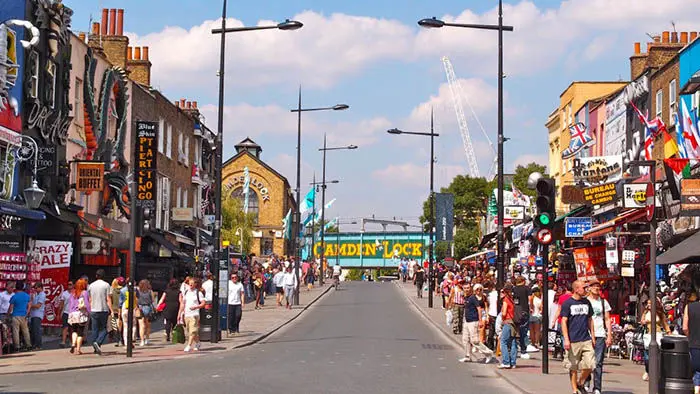
SHAKESPEARE’S GLOBE THEATRE
This is a replica of the original 1599 theater where Shakespeare presented his most famous works to the public.
During the middle of a performance, a fire started in one of its thatched roofs and completely destroyed the theatre.
A second theater was later built. However, the Puritans closed all London theaters in 1642, including the headquarters of the Shakespeare Company. As a result, the building was subsequently demolished.
At the end of the 20th century, Sam Wanamaker, a great Shakespeare admirer, managed to raise sufficient funds to reconstruct the theatre.
Currently, the theater puts on shows between May and October, as was the case during Shakespeare’s time, that you can enjoy with the audioguide (audioguides).
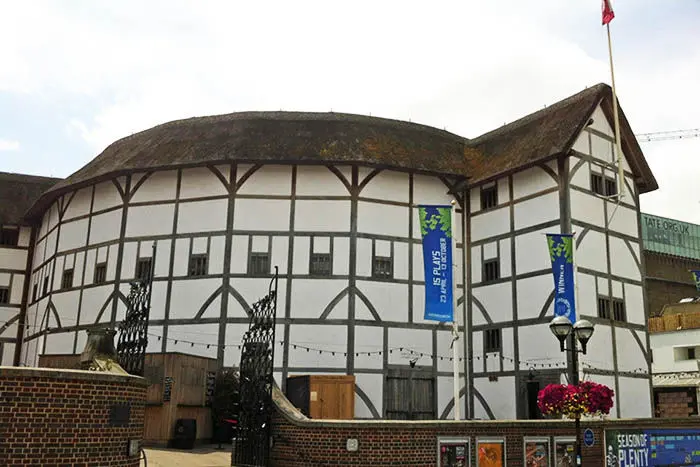
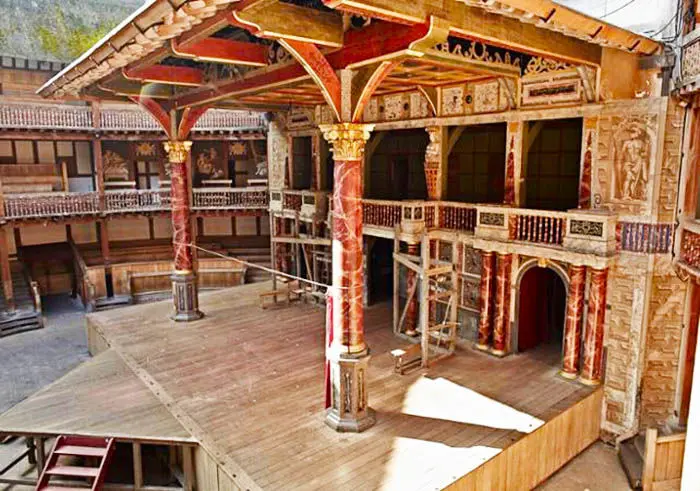
TRAFALGAR SQUARE
Trafalgar Square was built in 1830 to commemorate the victory of the British navy against the French and Spanish during the Battle of Trafalgar.
In the center is the Nelson column, which honors the admiral who died in battle while commanding his fleet.
Stretching 50 meters high, the column is guarded by four bronze lions who, according to legend, were built from the fused cannons of the French fleet.
With the audioguide (audioguides) you can see that various statues of famous historical figures are spread throughout the square such as George IV, James II, and George Washington. The latter is placed on land brought in from the United States, thus fulfilling the president’s wish to "never set foot on British soil again."
To thank the British for their support during the Second World War, Norway donates a giant tree every Christmas which towers over the square.
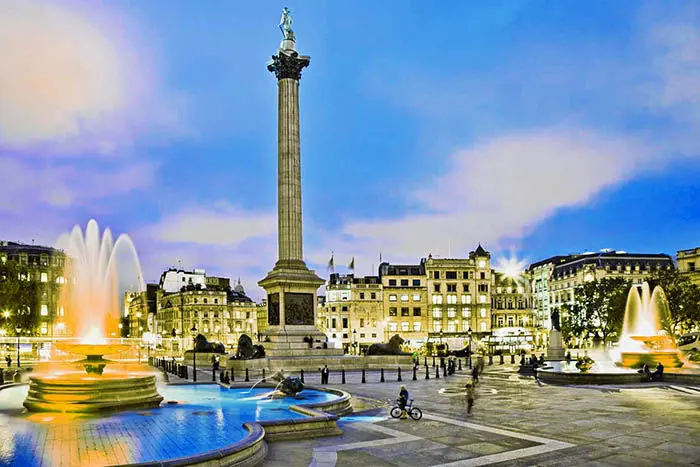
KENSINGTON PALACE
Kensington Palace has been the residence of the British monarchy since the 17th century.
During that time, it has been inhabited by William III, Queen Victoria, and Prince Charles and Princess Diana until their divorce. Diana would later live there with her children until her death. Currently, it is the residence of the Dukes of Cambridge when they are in London. Their official residence is in Wales.
Several important historical events regarding the royal family have occurred here. For example, Queen Anne died from a stroke caused by overeating, King George II passed away when a vein exploding while he was on the loo, and the palace was the scene of the coronation of Queen Victoria.
Inside, the king's apartments are decorated with the works of Tintoretto and Van Dyck, the tapestries of Mortlake, and the Court Dress Collection where you can see with the audioguide (audioguides) the history of courtesan attire.
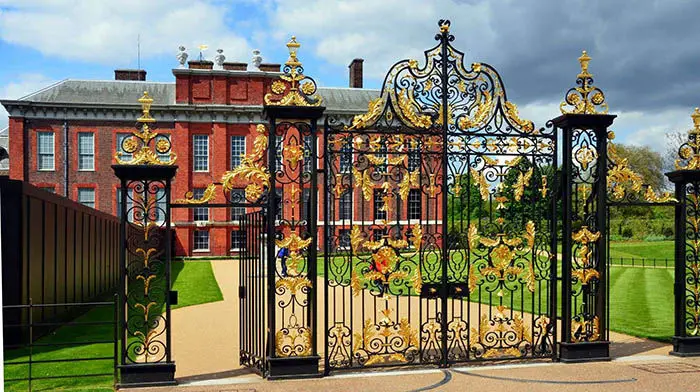
NATURAL HISTORY MUSEUM
The next interesting place of the audioguide (audioguides) is the Natural History Museum. This museum’s collection is composed of more than 70 million specimens and objects related to the natural world.
It was built in the late nineteenth century to accommodate the excessive number of items (such as skeletons and fossils) in the British Museum.
Within its exhibition spaces are the recreation of a life-size blue whale and the skeleton of a diplodocus. The museum also displays the evolution of our planet, the evolution of man, earthquake and volcano recreations, and a scientific exhibit called the Darwin Center.
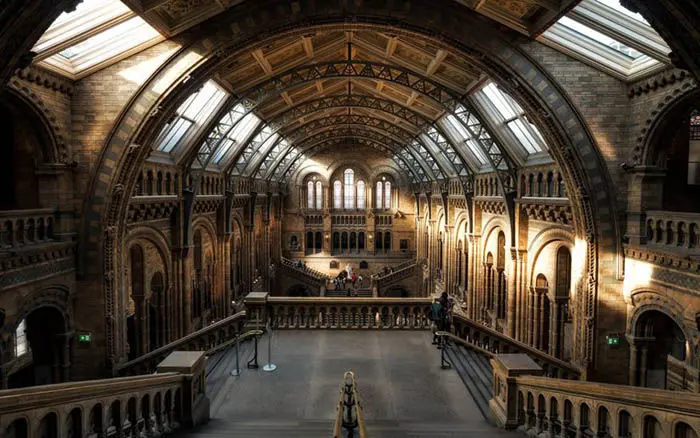
THE GREAT FIRE OF LONDON MONUMENT
This monument was built in memory of the Great Fire of London and commemorates the reconstruction of the city.
The fire started at the Thomas Farynor Bakery at dawn on September 2, 1666. The Farynor family, who were inside the house when it began, managed to escape. However, their maid was not so lucky and became the first victim of the disaster.
The great fire lasted four days, destroying thousands of houses and historic buildings. The number of deaths remains unknown.
The fire burned out of control until strong winds had subsided. London troops used gunpowder to create firebreaks and thus prevent its expansion.
The monument is built on the site of St Margaret’s, the first church to burn down, and has a height of 61 meters, the exact distance to the bakery where the fire began. At the top of the column is an urn in the shape of a flame, which contains ash from the original fire.
At its base, if you get closer with the audioguide (audioguides), you can read some Latin inscriptions which recall the catastrophe as well as the construction of the monument.
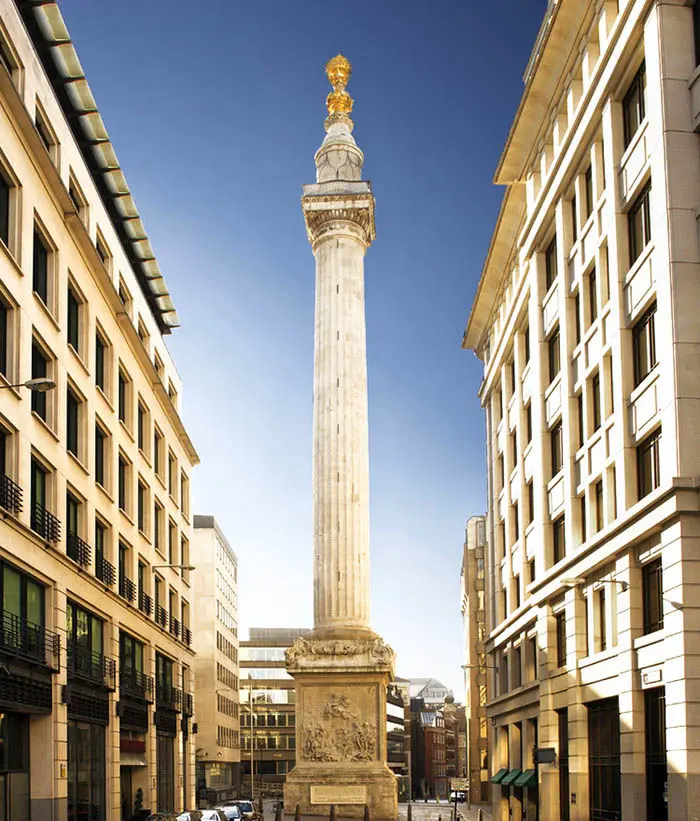
THE OLD OPERATING THEATRE MUSEUM
This old operating theatre is located in the garret of the Church of Saint Thomas. Within it, surgical experimentation of great medical significance took place.
The Saint Thomas’s Hospital is mentioned in 13th-century writings as a place where the poor could be treated.
In the late 17th century, London’s first operating theatre was built into the hospital’s herb depository. The poor who fell ill in the streets and could not afford an operation came here. The church monks experimented on them to learn more about anatomy as very little was known at the time. The opposite was true for those with money, however, who preferred to undergo their operations on their own kitchen tables instead.
Operations were done without anesthesia, so the monks gave their patients alcohol or opium to dull the pain. By the 19th century, medical students sat on the grandstands around the surgeon to record the details of each operation.
Inside, you can see with the audioguide (audioguides) various items related to these experimental surgeries, including instruments used to perform amputations and other operations.
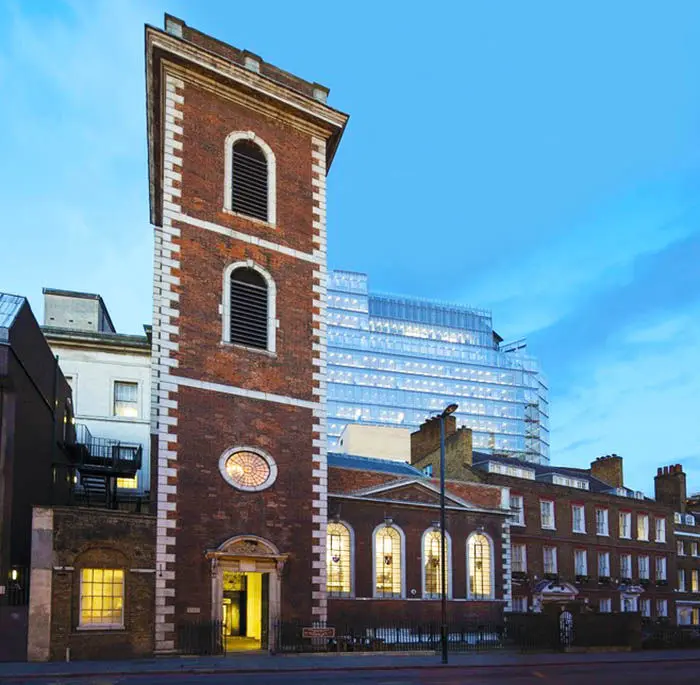
THE NATIONAL GALLERY
The National Gallery is located in Trafalgar Square and is the most important art collection in all of London.
Thirty-eight paintings from the private collection of banker John Julius Angerstein were the first pieces the British state bought to create an art museum. Afterward, the collection proliferated due to more purchases and donations.
At present, it is comprised of more than 2,300 works which showcase the evolution of art, from the early Renaissance period to the Post-impressionism movement. Highlights that you can enjoy with the audioguide (audioguides) include:
• Renaissance and Mannerism: Botticelli, Leonardo Da Vinci, Raphael, Michelangelo, Titian, Holbein, and Veronese.
• The Baroque period: Caravaggio, Rembrandt, Rubens, and Velázquez.
• Rococo, Impressionism and Post-Impressionism: Cézanne, Goya, Monet, and Van Gogh.
The museum closed during the Second World War, and many of its works were evacuated to Wales to avoid potential damage from bombing runs.
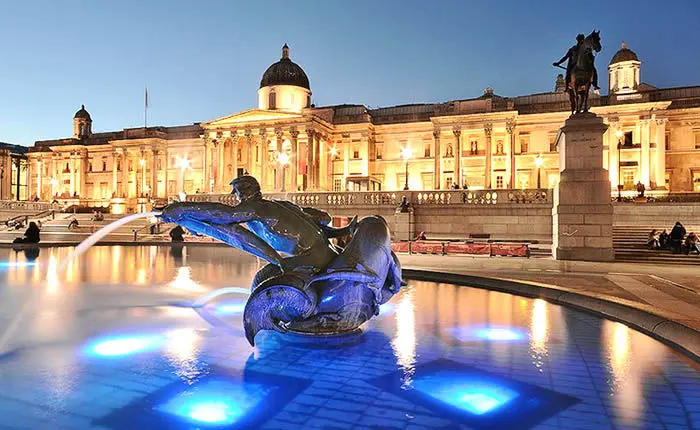
APSLEY HOUSE
This mansion is located within Hyde Park and was built for the Baron of Apsley. Later, the Duke of Wellington would acquire and renovate it.
Inside, the decor the Duke of Wellington personally selected remains intact. Even though he was not an art aficionado, he held a magnificent collection due to all the gifts he received for his military achievements. The collection you can see with the audioguide (audioguides) consists of more than 200 works by artists such as Velázquez, Van Dyck, Rubens, Brueghel the Elder, and Goya.
Highlights include a four-meter statue of Napoleon, pieces of Portuguese silverware, and a set of Sevres porcelain that once belonged to Louis XVIII.
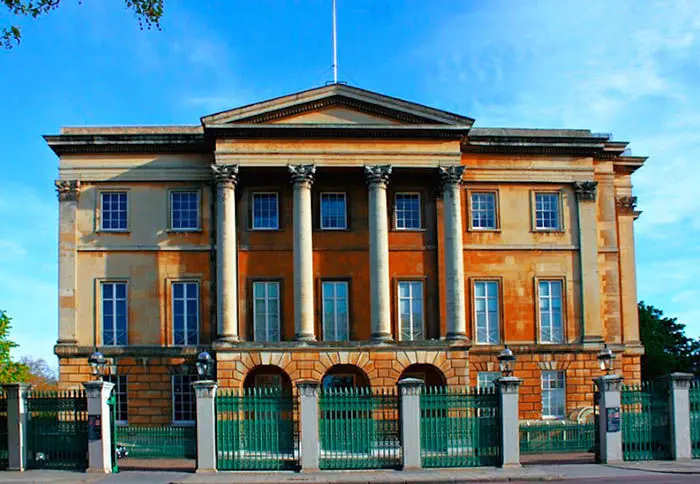
ST. JAMES'S PARK
Named in memory of the Saint James Hospital where leprosy patients were treated, the leafy St. James’s Park is considered the green lung of London.
King Henry VIII became interested in the land in the 16th century and converted it into his private hunting ground.
Later, King James II introduced exotic animals into the park such as camels, crocodiles, pelicans, and even an elephant.
At the end of the 17th century, it was turned into a French garden, gradually achieving the appearance you can see today with the audioguide (audioguides).
In the park is an artificial lake which is home to flora and fauna typical to the region. Within it are Duck Island and West Island. On the latter, a skeleton was found in 2011 and an investigation determined it had been there for three years. It turned out it was the remains of an American citizen who was obsessed with the Queen. His fixation consumed him, and he ended up dying on the tiny island in an attempt to be as close as possible to Her Majesty.
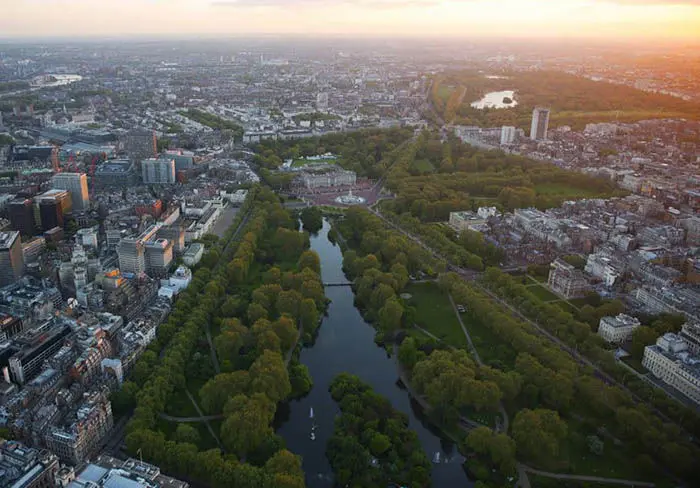

SHERLOCK HOLMES MUSEUM
Since opening in 1990, this museum has been dedicated to the stories of the famous fictional detective Sherlock Holmes.
Author Sir Arthur Conan Doyle tells us that Sherlock Holmes, along with Watson and Mrs. Hudson, lived at 221 Baker Street between 1881 and 1904. Fittingly, the museum is located at this address, and you can visit it with the audioguide (audioguides).
The three-story house is decorated exactly as it was described in the novels. Every little detail pays homage to the stories of Sherlock Holmes.
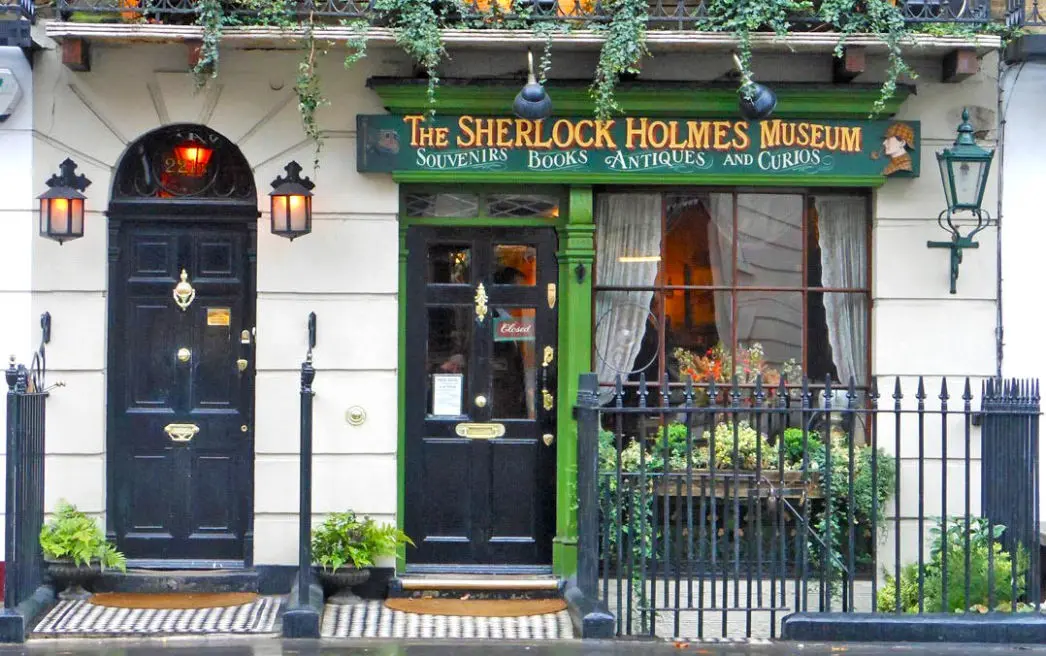
THE MILLENIUM BRIDGE
Next stop of the audioguide (audioguides), the 325-meter Millennium Bridge is London’s only pedestrian bridge.
The bridge opened in the year 2000 to much hype among Londoners.
However, just two days later, a design error forced its closure due to excessive wobbling as people tried to cross it. Once extensive readjustments to the structure had been made, it finally reopened in 2002.
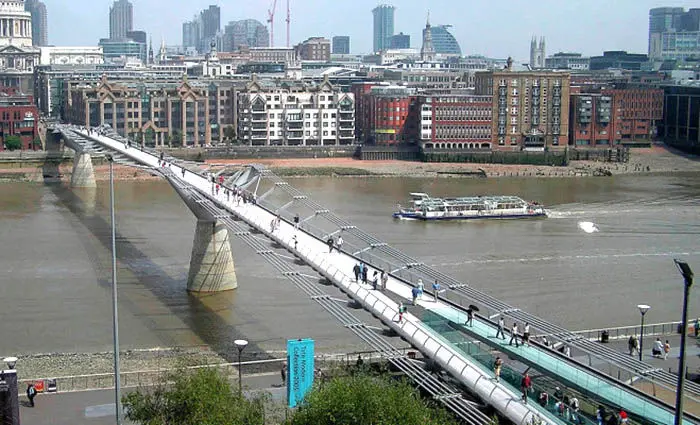
CITY HALL
Inaugurated in 2002, London’s City Hall is characterized by its futuristic oval shape. At 45 meters high, it boasts an innovative and energy efficient design.
Upon climbing its unusual helical staircase with the audioguide (audioguides), you will reach a breathtaking lookout from where you can see many of the city’s famous monuments.
The building serves as the Assembly Chamber and the offices for various city authorities.
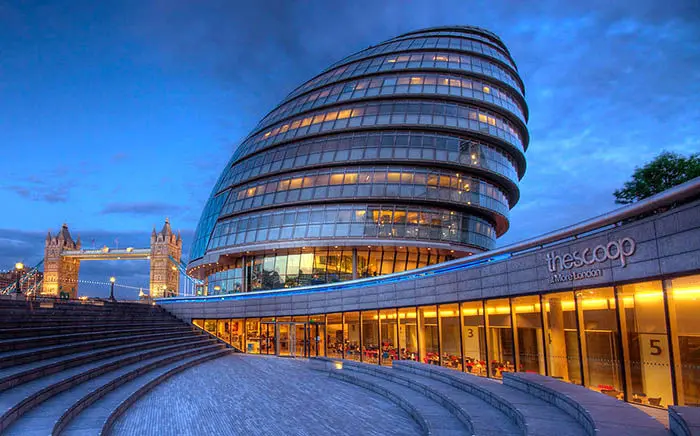
ROYAL ALBERT HALL
This landmark theater was constructed as a tribute to Prince Albert who died of cancer. His wife Queen Victoria inaugurated it in 1871. The highlight of the building is the impressive glass dome.
Throughout the year, the hall hosts more than 400 shows of varying types: concerts, conferences, tennis matches, awards ceremonies, and the well-known Festival of Remembrance which pays homage to fallen British soldiers.
On this stage, there have been concerts from Wagner and Rachmáninov, a conference held by Albert Einstein, a standout performance from Bob Dylan, and even a Eurovision Festival.
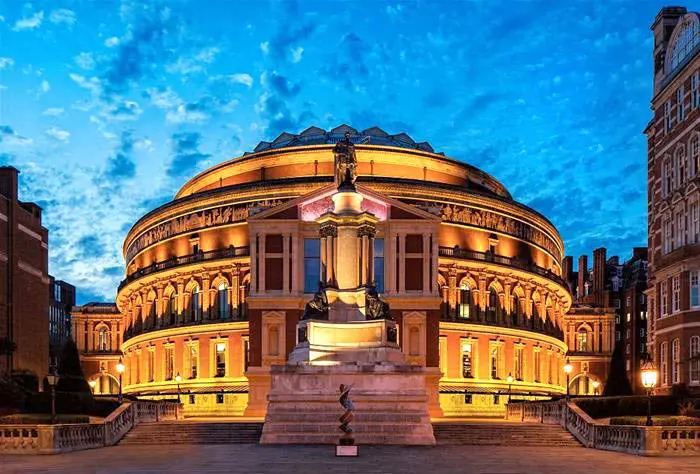
THE IMPERIAL WAR MUSEUM
Last point of this audioguide (audioguides), the Imperial War Museum takes us on a tour of all the great conflicts throughout history, with an emphasis on the awful consequences they entail.
The museum showcases military artifacts, weapons, vehicles, tanks, airplanes, and even an atomic bomb. It also holds official documents from various battles, as well as an abundance of photographic and audiovisual material.
The basement is the most exciting section of the museum. Here, you can see battle reconstructions of both world wars, complete with original artifacts. There’s also a small but harrowing exhibition dedicated to showing how children escaped the horrors of war by attempting to turn them into a game.
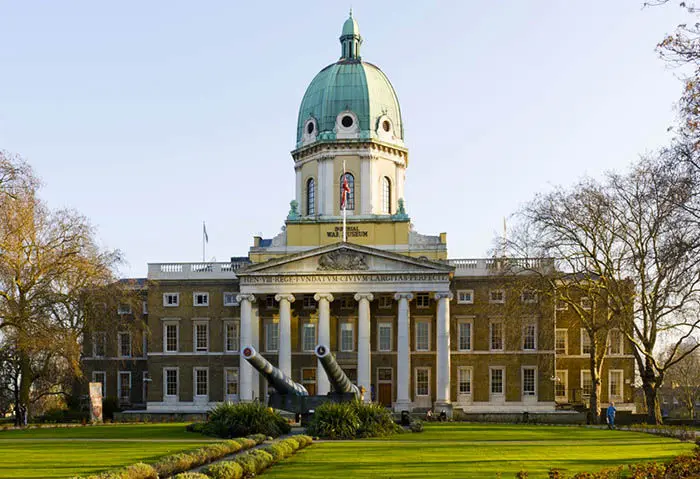
Audio guide devices, Multimedia audio guides,
Audio guide GPS tourist bus-train, charging bases and accessories.
Group guidance systems, headsets, charging cases, tour guide systems accessories.
Audioguides available from mobile devices, web App, downloadable App from Google Store.
Audioguides in several languages, translations, voiceovers. Audio descriptions, signoguides, visual contents for audioguides. 3D Reality.